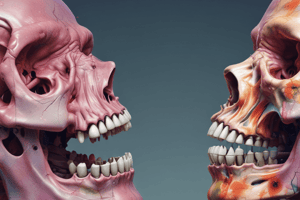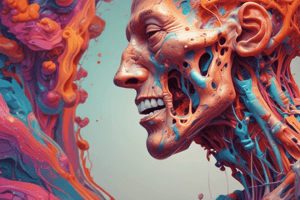Podcast
Questions and Answers
Which of the following is a contraindication for friction technique?
Which of the following is a contraindication for friction technique?
- Proud flesh or keloid scars, open, or healing scars (correct)
- Decreased range of motion due to scar contracture
- Decreased extensibility of subcutaneous connective tissue
- Chronic pain conditions
What is the purpose of using friction technique?
What is the purpose of using friction technique?
- To increase range of motion by stretching the tissue
- To numb the area and reduce pain
- To increase inflammation and bring fibroblasts and inflammatory proteins into the affected area (correct)
- To reduce inflammation and promote healing
What is the goal of the friction technique in terms of scar tissue?
What is the goal of the friction technique in terms of scar tissue?
- To completely eliminate the scar tissue
- To create a nonfunctional, misaligned scar
- To create a larger scar than the initial wound or injury
- To create a functional scar aligned with the tensile stress (correct)
What is the purpose of the stretch following the friction technique?
What is the purpose of the stretch following the friction technique?
How long should friction technique be applied for?
How long should friction technique be applied for?
What is the purpose of the Cyriax friction technique?
What is the purpose of the Cyriax friction technique?
What is the recommended pain scale for applying friction technique?
What is the recommended pain scale for applying friction technique?
What should the therapist assess before applying friction technique?
What should the therapist assess before applying friction technique?
Which of the following is not a contraindication for friction technique?
Which of the following is not a contraindication for friction technique?
What is the purpose of the analgesic effect that occurs after 1-2 minutes of friction technique?
What is the purpose of the analgesic effect that occurs after 1-2 minutes of friction technique?
What is the purpose of using cross-fiber frictions in scar tissue treatment?
What is the purpose of using cross-fiber frictions in scar tissue treatment?
How should a tendon with a synovial sheath be positioned during treatment?
How should a tendon with a synovial sheath be positioned during treatment?
What is the recommended rate of friction during treatment?
What is the recommended rate of friction during treatment?
When should cold hydrotherapy be used in scar tissue treatment?
When should cold hydrotherapy be used in scar tissue treatment?
What should be done if a client experiences increased discomfort during the friction therapy?
What should be done if a client experiences increased discomfort during the friction therapy?
Why is superficial effleurage recommended if a client has a negative response to friction therapy?
Why is superficial effleurage recommended if a client has a negative response to friction therapy?
What is the primary purpose of using friction techniques on scar tissue?
What is the primary purpose of using friction techniques on scar tissue?
What type of motion is used when applying friction techniques to scar tissue?
What type of motion is used when applying friction techniques to scar tissue?
When are friction techniques typically used in the rehabilitation process?
When are friction techniques typically used in the rehabilitation process?
What is the primary purpose of using friction techniques to prevent hypertrophic scar formation?
What is the primary purpose of using friction techniques to prevent hypertrophic scar formation?
Warm up the ______ tissue with hot hydrotherapy or with effleurage and specific petrissage.
Warm up the ______ tissue with hot hydrotherapy or with effleurage and specific petrissage.
Tissue is placed in an ______ position which allows for maximum separation of the fibers.
Tissue is placed in an ______ position which allows for maximum separation of the fibers.
For a tendon with a synovial sheath, the tendon is placed in ______ position so that there may be maximal force between the tendon and the sheath.
For a tendon with a synovial sheath, the tendon is placed in ______ position so that there may be maximal force between the tendon and the sheath.
Use ______ fingers or thumbs to compress the superficial tissue over the adhesion in a direction at right angles to the fibers of the structure that is being treated.
Use ______ fingers or thumbs to compress the superficial tissue over the adhesion in a direction at right angles to the fibers of the structure that is being treated.
Friction for ______ minutes.
Friction for ______ minutes.
Cold hydrotherapy to reduce post treatment ______ or if overtreatment occurs after 3 cycles or as self-care.
Cold hydrotherapy to reduce post treatment ______ or if overtreatment occurs after 3 cycles or as self-care.
MT-MT20 Techniques II Class 15-16: Frictions A repetitive non-gliding technique where specific contact such as a ______ or fingertip is used to penetrate dense connective tissue and produce small movements between its fibers.
MT-MT20 Techniques II Class 15-16: Frictions A repetitive non-gliding technique where specific contact such as a ______ or fingertip is used to penetrate dense connective tissue and produce small movements between its fibers.
Described first by ______ to breakdown existing and forming adhesions in muscles, tendons and ligaments.
Described first by ______ to breakdown existing and forming adhesions in muscles, tendons and ligaments.
Using a cross-fiber or ______ compressive motion of superficial tissue over deep tissue.
Using a cross-fiber or ______ compressive motion of superficial tissue over deep tissue.
Frictions can result in a local temporary ______ effect – after about 1 minute of fractioning.
Frictions can result in a local temporary ______ effect – after about 1 minute of fractioning.
Can prevent ______ (bigger than needed scar) scar formation by controlling inflammatory response.
Can prevent ______ (bigger than needed scar) scar formation by controlling inflammatory response.
Work from the ______ to the center of the scar.
Work from the ______ to the center of the scar.
Friction technique is contraindicated for ______ scars.
Friction technique is contraindicated for ______ scars.
Friction technique should not be done over ______ to avoid an electric shock sensation.
Friction technique should not be done over ______ to avoid an electric shock sensation.
Friction technique is contraindicated in the ______ stages of healing.
Friction technique is contraindicated in the ______ stages of healing.
Friction technique is contraindicated in ______ arthritis when in flare up.
Friction technique is contraindicated in ______ arthritis when in flare up.
Friction technique should not be applied too deep into the ______.
Friction technique should not be applied too deep into the ______.
Friction technique is contraindicated in clients with ______ medication use.
Friction technique is contraindicated in clients with ______ medication use.
Friction technique is contraindicated in clients with ______ tolerance.
Friction technique is contraindicated in clients with ______ tolerance.
The purpose of friction technique is to create ______ to bring proteins and clean up debris.
The purpose of friction technique is to create ______ to bring proteins and clean up debris.
The pressure of frictions should be within the client's ______ tolerance.
The pressure of frictions should be within the client's ______ tolerance.
The Cyriax friction technique is used for the treatment of ______.
The Cyriax friction technique is used for the treatment of ______.
Friction technique should not be applied too deep into the abdomen, as it can damage the viscera.
Friction technique should not be applied too deep into the abdomen, as it can damage the viscera.
Friction technique is contraindicated in clients with proud flesh or keloid scars, open, or healing scars.
Friction technique is contraindicated in clients with proud flesh or keloid scars, open, or healing scars.
Friction technique is contraindicated in the acute stages of healing.
Friction technique is contraindicated in the acute stages of healing.
Friction technique is contraindicated in clients with high pain tolerance, such as those with fibromyalgia.
Friction technique is contraindicated in clients with high pain tolerance, such as those with fibromyalgia.
The purpose of using cross-fiber frictions in scar tissue treatment is to increase functional mobility of the scar, promote connective tissue alignment, and reduce pain.
The purpose of using cross-fiber frictions in scar tissue treatment is to increase functional mobility of the scar, promote connective tissue alignment, and reduce pain.
Friction technique should be applied with the tips of the 2nd, 3rd and 4th digits or thumbs, with reinforcement.
Friction technique should be applied with the tips of the 2nd, 3rd and 4th digits or thumbs, with reinforcement.
Friction technique is contraindicated in clients with high analgesic medication use, such as anti-inflammatory, muscle relaxants, Tylenol, Aspirin, and blood thinners.
Friction technique is contraindicated in clients with high analgesic medication use, such as anti-inflammatory, muscle relaxants, Tylenol, Aspirin, and blood thinners.
The purpose of the friction technique is to separate adhesions and increase inflammation, which brings fibroblasts and inflammatory proteins into the affected area.
The purpose of the friction technique is to separate adhesions and increase inflammation, which brings fibroblasts and inflammatory proteins into the affected area.
Friction technique should be applied for a minimum of 20 minutes to be effective.
Friction technique should be applied for a minimum of 20 minutes to be effective.
Friction technique should not be done over nerves, as it can give the client an electric shock sensation.
Friction technique should not be done over nerves, as it can give the client an electric shock sensation.
The Cyriax friction technique is used to break down existing and forming adhesions in muscles, tendons, and ligaments.
The Cyriax friction technique is used to break down existing and forming adhesions in muscles, tendons, and ligaments.
Friction technique should not be applied too deep into the bone to avoid an electric shock sensation.
Friction technique should not be applied too deep into the bone to avoid an electric shock sensation.
Friction technique is contraindicated in the early stages of healing.
Friction technique is contraindicated in the early stages of healing.
Friction technique can prevent hypertrophic (bigger than needed) scar formation by controlling the inflammatory response.
Friction technique can prevent hypertrophic (bigger than needed) scar formation by controlling the inflammatory response.
Friction technique should be applied using a cross-fiber or circular compressive motion of superficial tissue over deep tissue.
Friction technique should be applied using a cross-fiber or circular compressive motion of superficial tissue over deep tissue.
The purpose of using cross-fiber frictions is to increase gliding between fibers in the structure being treated.
The purpose of using cross-fiber frictions is to increase gliding between fibers in the structure being treated.
When treating a tendon without a synovial sheath, it is best positioned in a neutral position.
When treating a tendon without a synovial sheath, it is best positioned in a neutral position.
Frictions should be applied at a fast rate of 3-4 times per second for optimal results.
Frictions should be applied at a fast rate of 3-4 times per second for optimal results.
The length of movement when applying frictions should be more than 2cm to encompass a larger area.
The length of movement when applying frictions should be more than 2cm to encompass a larger area.
It is recommended to apply friction for a maximum of 30 minutes per cycle.
It is recommended to apply friction for a maximum of 30 minutes per cycle.
If the client experiences increased discomfort during friction therapy, it is best to stop the technique and apply heat directly to the treated area.
If the client experiences increased discomfort during friction therapy, it is best to stop the technique and apply heat directly to the treated area.
Flashcards are hidden until you start studying




